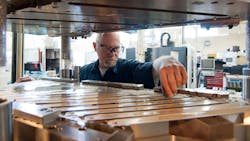Tool and die making is one of those professions that prompts a layperson to ask, open-mouthed, “does that job still exist?” In 2016, nearly 75% of tool and die makers were over age 45, according to study from by Center for Automotive Research. Only 2% were younger than 35. Two of five are either already eligible to retire, or will be in the next 5 to 7 years.
Although the job numbers are dwindling, tool and die making is still a necessary skill in the U.S., where automakers and aerospace companies need precision machinists and moldmakers to do the fine work onsite or near their operations.
With high schools no longer offering specialized vocational training and apprenticeship programs a shadow of what they were 30 or 40 years ago, the National Tooling and Machining Association, which represents precision custom manufacturers, has ramped up its training in recent years. A newish online curriculum called NTMA-U offers coursework in metallurgy, moldmaking, dimensional metrology, advanced diemaking.
It also founded and supports* the National Institute of Metalworking Skills (NIMS), a credentialing program for precision machinists who have completed specialized training through their school or company. NIMS offers “train the trainer” workshops as well.
Dean Bartles, the new president of NTMA, says he is looking for ways to improve the curriculum and plans on spending the next six months visiting some of the organization’s 1,300 member companies, the bulk of them small and medium-sized operations, to find out what their needs and concerns are. Along with advocacy, NTMA can offer resources to help them the smaller players navigate and afford emerging technologies for their operations, he says.
Bartles, who has held a variety of association roles in the past decade, shepherded the development and construction of the John Olson Advanced Manufacturing Center at the University of New Hampshire, which opened in June 2018. The center was designed to combine classroom engineering work with hands-on manufacturing training and visualization.
But he spent of the bulk of his career—35 years—in aerospace manufacturing. For 13 years, he was vice president and general Manager of the Ordnance and Tactical Systems Division at General Dynamics, overseeing three plants, including one in Joplin, Pennsylvania, that produced large-caliber ammunition. The Joplin plant manufactured lightweight tactical vehicles for artillery systems. “Special Forces had a requirement for a small vehicle designed to go up narrow mountain paths in Afghanistan,” he says. “We won the contract. That was my swan song.”
Early in his career, he worked in specialized machining operations for several companies, including General Defense Corp., Olin Ordnance, and Fairchild Republic Company, at plants in Turkey and Egypt as well as in the United States.
Another priority for Bartles is working with industry to further develop MT Connect, an open-source protocol for the industry allows exchange of data between any machine tool, so machines with different software can share data. Bartles is on the board of the non-profit MTConnect Institute, which is developing the free, open standard.
*The article originally incorrectly stated that NTMA runs NIMS. It has been corrected to accurately reflect NTMA's role.
About the Author

Laura Putre
Senior Editor, IndustryWeek
As senior editor, Laura Putre works with IndustryWeek's editorial contributors and reports on leadership and the automotive industry as they relate to manufacturing. She joined IndustryWeek in 2015 as a staff writer covering workforce issues.
Prior to IndustryWeek, Laura reported on the healthcare industry and covered local news. She was the editor of the Chicago Journal and a staff writer for Cleveland Scene. Her national bylines include The Guardian, Slate, Pacific-Standard and The Root.
Laura was a National Press Foundation fellow in 2022.
Got a story idea? Reach out to Laura at [email protected]
